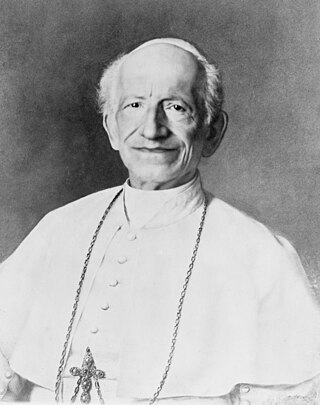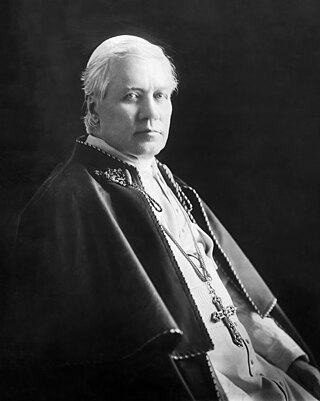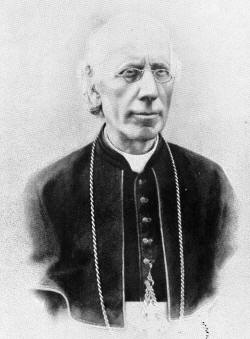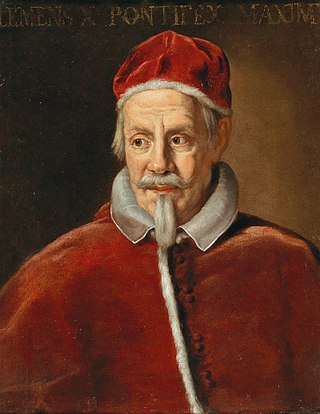
The relationship between Pope Leo XIII and Poland was marked by the German-led Kulturkampf, which led to the persecution of ethnic Poles in Prussia and German Catholics in Germany.

The relationship between Pope Leo XIII and Poland was marked by the German-led Kulturkampf, which led to the persecution of ethnic Poles in Prussia and German Catholics in Germany.
In Prussia, Polish Catholics were persecuted as Poles and, during the Kulturkampf, together with German Catholics, as Catholics as well: The Kulturkampf, which Otto von Bismarck began in 1871, insinuated a Polish-Catholic-Austrian connection. It was a vehicle for germanisation, as everything Polish including the language were banned from schools and offices. [1]
Polish priests, who taught Catholic religion in Polish were punished and jailed. Like their German counterparts, their sermons were observed and led to jail sentences as well. [2] In 1874, Cardinal Mieczyslaw Ledóchowski was jailed.
Unlike in Russia, they had powerful allies among German Catholic hierarchy and Catholic politicians like Matthias Erzberger, the most prominent Catholic politician during World War I, who often functioned as go-between with the Vatican. (Erzberger 41 ff) Indeed, after Vatican communications, Erzberger promoted a Polish kingdom to be proclaimed in Kraków with loose ties to Austria-Hungary, for which he had support in the Vatican and even Germany (Erzberger, 173) but not from the Hungarian Prime Minister Tisza in Vienna, who was afraid of losing ethnic influence.
According to Erzberger, Germany proposed on one hand a large Poland to be associated with Austria-Hungary and Germany in a central-European economic union. On the other hand, German fiscal policies continued discriminating against Polish interests. Largely due to the British blockage against Germany, Polish populations suffered from hunger during German occupation, with the result, that Prussian popularity reached all time lows during World War I. [3]
During the conclave of 1903, according to its Secretary Rafael Merry del Val, Cardinal Jan Puzyna de Kosielsko of Kraków came to see him, demanding to announce his veto against Cardinal Rampolla in the name of Emperor Franz Joseph I of Austria. Merry Del Val protested and refused to even accept the document, which, in the heat of the debate fell on the floor and was picked up by Jan Puzyna de Kosielsko. The College of Cardinals, was outraged. Rampolla, according to Merry del Val, actually gained votes after the veto. Later, he opined to Ludwig von Pastor that Rampolla never had a chance, because the cardinals wanted a new direction after the pontificate of Pope Leo XIII. After his election, the new Pope Pius X decreed automatic excommunication on anyone who should try to influence a conclave with a threat or veto. [4]

Pope Leo XIII was head of the Catholic Church from 20 February 1878 until his death in July 1903. Living until the age of 93, he was the oldest pope holding office, and had the fourth-longest reign of any pope, behind those of St. Peter, Pius IX and John Paul II.

Pope Pius X was head of the Catholic Church from 4 August 1903 to his death in August 1914. Pius X is known for vigorously opposing modernist interpretations of Catholic doctrine, and for promoting liturgical reforms and scholastic theology. He initiated the preparation of the 1917 Code of Canon Law, the first comprehensive and systemic work of its kind. He is venerated as a saint in the Catholic Church. The Society of Saint Pius X, a traditionalist Catholic fraternity, is named after him.

Pope Benedict XV, born Giacomo Paolo Giovanni Battista della Chiesa, was head of the Catholic Church from 1914 until his death in January 1922. His pontificate was largely overshadowed by World War I and its political, social, and humanitarian consequences in Europe.
Papabile is an unofficial Italian term first coined by Vaticanologists and now used internationally in many languages to describe a Catholic man, in practice always a cardinal, who is thought a likely or possible candidate to be elected pope.

Mariano Rampolla del Tindaro was an Italian Cardinal in the Roman Catholic Church, and the last man to have his candidacy for papal election vetoed through jus exclusivae by a Catholic monarch.

Prince Jan Duklan Maurycy Paweł Puzyna de Kosielsko was a Polish Roman Catholic Cardinal who was auxiliary bishop of Lwów from 1886 to 1895, and the bishop of Kraków from 1895 until his death in 1911. Named a Cardinal in 1901, he was known for his conservative views and authoritarianism.

The papal conclave held from 31 July to 4 August 1903 saw the election of Cardinal Giuseppe Melchiorre Sarto to become pope in succession to Leo XIII, who had died on 20 July after a 25-year-long pontificate. Some 62 cardinals participated in the balloting. Emperor Franz Joseph of Austria asserted the right claimed by certain Catholic rulers to veto a candidate for the papacy, blocking the election of the leading candidate, Cardinal Secretary of State Mariano Rampolla. Sarto was elected on the seventh ballot and took the name Pius X.

A papal conclave was held from 31 August to 3 September 1914 which elected Giacomo della Chiesa to succeed Pius X, who died on August 20, as pope. Della Chiesa, hitherto the archbishop of Bologna, took the name Benedict XV.

The papal conclave held from 2 to 6 February 1922 saw Cardinal Achille Ratti elected to succeed Benedict XV, who had died on 22 January 1922. It took fourteen ballots for the 53 of the 60 cardinals assembled in the Sistine Chapel to elect a new pope. Ratti took the name Pius XI and immediately revived the traditional public blessing from the balcony, Urbi et Orbi, which his predecessors had eschewed since the loss of Rome to the Italian state in 1870.

Rafael Merry del Val y Zulueta, was a Spanish Catholic bishop, Vatican official, and cardinal.
Jus exclusivae was the right claimed by several Catholic monarchs of Europe to veto a candidate for the papacy. Although never formally recognized by the Catholic Church, the monarchs of France, Spain and Austria claimed this right at various times, making known to a papal conclave, through a crown-cardinal, that the monarch deemed a particular candidate for the papacy objectionable.

Luigi Oreglia di Santo Stefano was a cardinal of the Catholic Church in the late nineteenth century. He was Bishop of Ostia e Velletri and Dean of the Sacred College of Cardinals from 1896 until his death.

Anton Josef Gruscha, S.T.D. was a Cardinal of the Roman Catholic Church and was Archbishop of Vienna.

Bartolomeo Bacilieri was an Italian Cardinal of the Roman Catholic Church. He served as Bishop of Verona from 1900 until his death, and was elevated to the cardinalate in 1901.

Ottavio Cagiano de Azevedo was an Italian Cardinal of the Roman Catholic Church. He served as Prefect of the Sacred Congregation for Religious from 1913 to 1915, and was elevated to the cardinalate in 1905.

The 1721 papal conclave, convoked after the death of Pope Clement XI, elected Cardinal Michelangelo de' Conti, who took the name of Innocent XIII.

The 1669–70 papal conclave was convened on the death of Pope Clement IX and ended with the election of Cardinal Emilio Altieri as Pope Clement X. The election saw deference within the College of Cardinals to Louis XIV of France, and a freeing of the cardinals loyal to Spain to vote according to their conscience. Eventually the elderly Altieri was elected with support of the major factions within the College.

The 1724 papal conclave was called upon the death of Pope Innocent XIII. It began on 20 March 1724 and ended on 28 May that year with the election of Cardinal Vincenzo Maria Orsini, a Dominican friar, as Pope Benedict XIII. The conclave was made of largely the same electors that had elected Innocent in 1721 and the same factions dominated it. Multiple attempts were made to elect candidates that would be acceptable to the various Catholic monarchies at the time, but none were successful until May. Benedict resisted his own election for two days before being convinced to accept it.

The 1730 papal conclave elected Pope Clement XII as the successor to Pope Benedict XIII.

Luigi Galimberti was an Italian prelate of the Catholic Church who had a varied career as an academic and theologian, journalist, diplomat, and Vatican official. He became an archbishop in 1887 and a cardinal in 1893. He was considered a candidate for the papacy when he died at the age of 60.